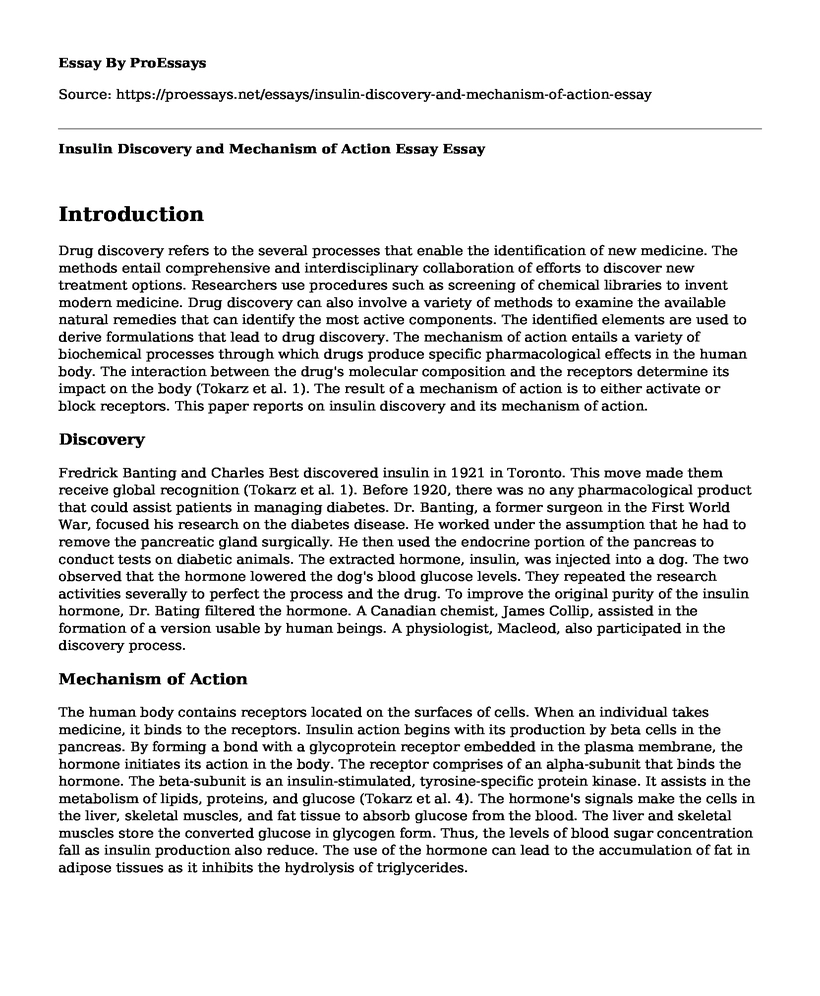Introduction
Drug discovery refers to the several processes that enable the identification of new medicine. The methods entail comprehensive and interdisciplinary collaboration of efforts to discover new treatment options. Researchers use procedures such as screening of chemical libraries to invent modern medicine. Drug discovery can also involve a variety of methods to examine the available natural remedies that can identify the most active components. The identified elements are used to derive formulations that lead to drug discovery. The mechanism of action entails a variety of biochemical processes through which drugs produce specific pharmacological effects in the human body. The interaction between the drug's molecular composition and the receptors determine its impact on the body (Tokarz et al. 1). The result of a mechanism of action is to either activate or block receptors. This paper reports on insulin discovery and its mechanism of action.
Discovery
Fredrick Banting and Charles Best discovered insulin in 1921 in Toronto. This move made them receive global recognition (Tokarz et al. 1). Before 1920, there was no any pharmacological product that could assist patients in managing diabetes. Dr. Banting, a former surgeon in the First World War, focused his research on the diabetes disease. He worked under the assumption that he had to remove the pancreatic gland surgically. He then used the endocrine portion of the pancreas to conduct tests on diabetic animals. The extracted hormone, insulin, was injected into a dog. The two observed that the hormone lowered the dog's blood glucose levels. They repeated the research activities severally to perfect the process and the drug. To improve the original purity of the insulin hormone, Dr. Bating filtered the hormone. A Canadian chemist, James Collip, assisted in the formation of a version usable by human beings. A physiologist, Macleod, also participated in the discovery process.
Mechanism of Action
The human body contains receptors located on the surfaces of cells. When an individual takes medicine, it binds to the receptors. Insulin action begins with its production by beta cells in the pancreas. By forming a bond with a glycoprotein receptor embedded in the plasma membrane, the hormone initiates its action in the body. The receptor comprises of an alpha-subunit that binds the hormone. The beta-subunit is an insulin-stimulated, tyrosine-specific protein kinase. It assists in the metabolism of lipids, proteins, and glucose (Tokarz et al. 4). The hormone's signals make the cells in the liver, skeletal muscles, and fat tissue to absorb glucose from the blood. The liver and skeletal muscles store the converted glucose in glycogen form. Thus, the levels of blood sugar concentration fall as insulin production also reduce. The use of the hormone can lead to the accumulation of fat in adipose tissues as it inhibits the hydrolysis of triglycerides.
Potential Application in the Treatment of Diabetes
The insulin hormone applies to the treatment of diabetes. The hormone successfully changes an individual's blood sugar levels at a faster rate. Higher blood sugar levels pose a threat to the wellbeing of diabetes patients. If unaddressed promptly, it can lead to organ failure and complications. These include kidney issues and blindness. The hormone plays a central role in establishing a healthy balance in the amounts of blood sugar levels present in the body (Tokarz et al. 9). Insulin balances the two levels by initiating measures to store and release glucose at specific times. Insulin can help in managing diabetes in patients through combined efforts with other strategies such as proper dieting and exercising. Thus, the hormone has the potential to serve as a medical solution that corrects metabolism abnormalities.
Conclusion
In conclusion, drug discovery is the use of methods such as screening by medical researchers to develop new medicines to combat diseases. Mechanism of action refers to the biochemical processes of drug components. The interaction between the drugs and the human body results in specific outcomes. Drug discovery for the treatment of diabetes occurred in 1921. The research activities of Dr. Banting and Charles Best led to the development of insulin in the pancreas. Insulin works by stimulating the absorption of glucose from the blood by the liver and skeletal muscles. Thus, insulin is essential for the treatment of diabetes.
Work Cited
Tokarz, Victoria L., Patrick E. MacDonald, and Amira Klip. "The Cell Biology of Systemic Insulin Function." The Journal of Cell Biology, vol. 217, no. 7. 2018, pp. 1-17. doi: 10.1083/jcb.201802095
Cite this page
Insulin Discovery and Mechanism of Action Essay. (2022, Sep 15). Retrieved from https://proessays.net/essays/insulin-discovery-and-mechanism-of-action-essay
If you are the original author of this essay and no longer wish to have it published on the ProEssays website, please click below to request its removal:
- Management Essay Example: Phases in Implementing Change
- Consequences of Breaking Ethics Rule in Nursing - Essay Sample
- Teaching Strategies in Nursing Paper Example
- Benner's Nursing Theory Paper Example
- Sony Company's Communication Challenges With Hearing-Impaired Customers - Essay Sample
- Paper on Baptist Health System's 4Ps Marketing Strategy: A Case Study
- Commitment to Social Work: Pursuing a Master's Degree with a Focus on Social Justice and Diversity - Free Paper







